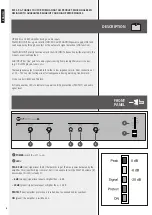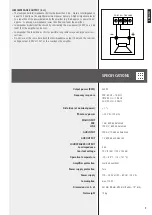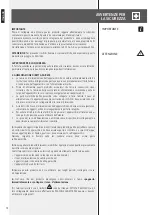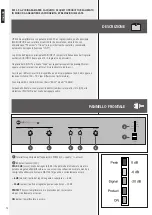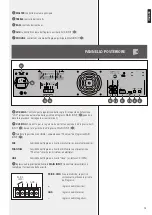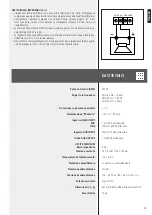
9
ENGLISH
LOW IMPEDANCE OUTPUT (4
Ω
)
-
The loudspeaker total impedance shall not be lower than 4
Ω
. Note: a total impedance
equal to 4
Ω
allows the amplifier maximum power delivery. A higher impedance leads
to a reduction of the power delivered by the amplifier (e.g. 8
Ω
: approx. ½ power, 16
Ω
:
approx. ¼ power). An impedance lower than 4
Ω
overloads the amplifier.
-
Loudspeaker models shall be chosen by considering the max. power (240 W on a 4
Ω
load) that the amplifier can deliver.
-
Loudspeaker line should be as short as possible; long cables may need large wire cross-
sections.
-
Do not use, at the same time, both the low impedance output (4
Ω
) and the constant
voltage output (100V or 70V), as this overloads the amplifier.
SPECIFICATIONS
Output power (RMS)
Frequency response
Distortion (at nominal power)
‘Phantom’ power
MAIN INPUT
MIC
LINE
AUX INPUT
AUX OUTPUT
LOUDSPEAKER OUTPUT
Low impedance
Constant voltage
Operation temperature
Amplifier protection
Power supply protection
Power supply
Consumption
Dimensions (w, h, d)
Net weight
240 W
MIC: 60 Hz ÷ 15 kHz
LINE: 50 Hz ÷ 18 kHz
AUX: 50 Hz ÷ 20 kHz
< 1 %
> 20 V dc. (20 mA)
1 mV, 600
Ω
, balanced
100 mV, 600
Ω
, balanced
200 mV, 10 k
Ω
, unbalanced
1 V, 600
Ω
, unbalanced
4
Ω
70 V (21
Ω
) / 100 V (42
Ω
)
–10 ÷ 55 °C (14 ÷ 131 °F)
overload, overheat
fuse
115 – 230V ac (50 – 60 Hz) / 24 V dc
max. 720 W
431 mm, 88 mm, 385 mm (2 units – 19” rack)
14 kg
COM 4
Ω
70V 100V






